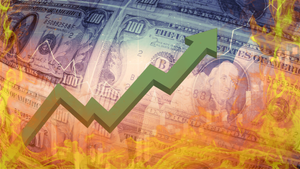
European stock markets are experiencing a remarkable surge, with key indices reaching unprecedented levels as of October 8, 2025. This robust performance is signaling a significant shift in investor sentiment towards the continent's equities, driven by a confluence of factors ranging from anticipated monetary easing by central banks to a burgeoning optimism surrounding artificial intelligence and strategic governmental spending. The immediate implication is a renewed confidence in Europe's economic resilience and growth prospects, attracting capital flows and setting the stage for continued market dynamism.
Unprecedented Ascent: A Detailed Look at Europe's Market Rally
The current rally across European bourses marks a period of exceptional growth, with several benchmark indices not just recovering, but setting new all-time highs. As of October 8, 2025, the Euro Stoxx 50 (EU50) index, representing the Euro Area's largest companies, climbed to 5624 points, marking a 0.24% gain from the previous session and a significant 4.75% rise over the past month. It even touched an all-time high of 5675.70 earlier in October, closing at its second-highest level in history. Similarly, the pan-European STOXX 600 (STOXX) advanced by 0.5% on October 8, breaking a two-session losing streak, and had previously risen to fresh record highs on October 3. Between September 25 and October 3, the STOXX 600 surged an impressive 3.7%, outperforming its U.S. counterparts like the S&P 500 and Nasdaq during that period, with a year-to-date return of 25% in US dollar terms as of October 6, 2025.
London's FTSE 100 (FTSE:UKX) also joined the record-breaking spree, hitting a new intraday high and closing at 9548.87 on October 8, up 0.69% for the day, contributing to a 16.83% year-to-date increase. Germany's DAX (DAX) index closed 0.87% higher at 24597.13, setting a new record close and demonstrating a robust 23.55% year-to-date rise. Even the French CAC 40 (CAC) index, despite recent political uncertainties, advanced to 8045 points on October 8, gaining 0.88% from the previous session, with a 3.81% climb over the past month. This broad-based ascent indicates a strong underlying positive sentiment across the continent.
The timeline leading up to this moment has been characterized by a confluence of supportive global and regional developments. A pivotal driver has been the anticipation of continued monetary easing, particularly from the U.S. Federal Reserve, which initiated an easing cycle in September 2025. This has fostered a "risk-on" sentiment globally, benefiting European markets. Furthermore, a pervasive optimism surrounding Artificial Intelligence (AI) and technology has fueled a significant rally in the tech sector, with companies like ASML Holding (AMS:ASML) demonstrating strong individual performances. Governmental policies also play a crucial role, with the European Union and national governments, notably Germany's substantial €500 billion plan for infrastructure and defense spending, providing significant stimulus. The improving Eurozone macroeconomic backdrop, evidenced by 0.1% GDP growth in Q2 2025 and lower inflation, further bolsters investor confidence.
Initial market reactions have been overwhelmingly positive, marked by a noticeable reallocation of capital into European equities, which are perceived to offer attractive valuations compared to their U.S. counterparts. Sector-specific momentum has been observed, with steelmakers enjoying strong gains following EU announcements on import quotas and tariffs, and financials and healthcare stocks also showing strong resurgence. However, not all sectors have fared equally, with the automotive sector, including companies like BMW (BMW:GR) and Mercedes-Benz (MBG:GR), experiencing declines after BMW cut its 2025 earnings forecast due to U.S. tariffs and weaker Chinese market growth.
Corporate Fortunes: Winners and Losers in a Rising Market
The robust performance of European stock markets has created clear winners and, in some cases, highlighted sectors facing headwinds. The technology sector, riding the global wave of AI optimism, has been a significant beneficiary. Companies like ASML Holding (AMS:ASML), a Dutch multinational specializing in the development and manufacturing of photolithography systems, have seen their stock prices surge, contributing substantially to the overall market gains. As a key enabler of advanced chip manufacturing, ASML's performance underscores the critical role of AI infrastructure in today's economy.
Steelmakers across Europe have also experienced strong gains. This uplift comes after strategic policy announcements from the EU to reduce tariff-free steel import quotas and increase tariffs on excess imports. This protective measure has provided a significant boost to domestic producers, making companies like ArcelorMittal (AMS:MT), one of the world's leading steel and mining companies, potential beneficiaries. The protective tariffs aim to level the playing field for European steel producers against international competition, directly impacting their profitability and market valuation.
The financial sector, including major banks and financial institutions, has also led advances in indices like the FTSE 100 (FTSE:UKX). This can be attributed to a combination of factors, including specific company news such as lower-than-expected compensation costs for loan mis-selling, and a generally improving economic outlook that bodes well for lending and investment activities. Companies like HSBC Holdings plc (LSE:HSBA) and Lloyds Banking Group plc (LSE:LLOY) are poised to benefit from a more stable economic environment and potentially higher interest rate margins in the long term, should the easing cycle proceed cautiously. Healthcare stocks are also showing a resurgence, considered to have significant potential without being overvalued, suggesting companies like Novo Nordisk A/S (CPH:NOVO B) or Roche Holding AG (SIX:ROG) could see continued investor interest.
Conversely, the automotive sector has largely lagged behind the broader market rally. Companies such as BMW (BMW:GR) and Mercedes-Benz Group AG (MBG:GR) have experienced declines, primarily due to external pressures. BMW, for instance, cut its 2025 earnings forecast, citing the impact of U.S. tariffs and weaker market growth in China. This highlights the vulnerability of export-oriented industries to global trade tensions and shifts in major consumer markets. The ongoing transition to electric vehicles also presents significant investment costs and competitive pressures, which could weigh on traditional automakers' profitability in the short to medium term.
Wider Significance: A Shifting Global Landscape
The current European market rally is not merely an isolated event but rather a significant indicator of broader industry trends and a shifting global economic landscape. The sustained outperformance of European equities against other major global markets throughout 2025 suggests a fundamental reassessment of their value proposition by international investors. This event fits into a larger narrative of diversification, where investors are actively seeking opportunities beyond traditionally dominant markets, particularly as European valuations remain attractive relative to their U.S. counterparts.
The ripple effects of this surge are multifaceted. For competitors and partners, particularly those in the U.S. and Asia, the robust performance of European companies could intensify competition in key sectors like technology, manufacturing, and financials. European companies, bolstered by stronger market valuations, may find themselves in a better position for mergers and acquisitions, research and development investments, and global expansion. Conversely, U.S. companies might see increased capital outflows as investors reallocate funds to Europe, potentially impacting their own market performance.
Regulatory and policy implications are also substantial. The proactive governmental spending plans, such as Germany's €500 billion infrastructure and defense initiative, signal a commitment to stimulating economic growth and innovation. This could lead to further policy coordination within the EU to foster a more integrated and resilient single market. The EU's protective measures for steel imports also highlight a growing trend towards safeguarding key domestic industries, which could prompt other sectors to seek similar protections. Historically, periods of strong market performance often follow significant policy interventions or shifts in global economic power dynamics, and this current rally aligns with a period of increased strategic autonomy and economic cohesion within Europe.
Comparing this to historical precedents, the current environment shares similarities with previous periods of strong regional growth driven by a combination of supportive monetary policy and targeted fiscal stimulus. However, the unique element of pervasive AI optimism distinguishes this rally, suggesting a deeper, technology-driven transformation at play. The resilience of French stocks (CAC 40) despite political instability also marks a notable deviation, indicating that fundamental economic improvements and investor confidence can sometimes override domestic political noise, at least in the short term.
What Comes Next: Navigating Opportunities and Challenges
Looking ahead, the European market's strong momentum presents both short-term and long-term possibilities. In the short term, continued investor confidence, fueled by anticipated monetary easing and improving economic data, could sustain the upward trajectory. The "risk-on" sentiment is likely to persist, encouraging further capital inflows. However, potential headwinds such as ongoing political instability in France or the risk of reaccelerating U.S. inflation could introduce volatility, necessitating careful monitoring by investors.
In the long term, European companies may need to strategically pivot or adapt to fully capitalize on this favorable environment. Enhanced investment in digital transformation, sustainable technologies, and further integration into global supply chains will be crucial. The increased defense spending across Europe, for instance, presents significant opportunities for defense contractors and related industries, requiring them to scale up production and innovation. For the broader market, the focus will shift towards earnings growth and the ability of companies to translate macroeconomic improvements into tangible financial performance.
Market opportunities will likely emerge in sectors poised for structural growth, such as renewable energy, advanced manufacturing, and biotechnology, complementing the current strength in AI and technology. Challenges will include managing potential inflationary pressures if economic growth accelerates too quickly, navigating geopolitical uncertainties, and ensuring that the benefits of market growth are broadly distributed to avoid social and economic disparities.
Potential scenarios range from a continued, steady ascent, supported by consistent policy and economic fundamentals, to periods of consolidation or even corrections if external shocks or unforeseen domestic issues arise. A key outcome will be whether Europe can solidify its position as a globally competitive investment destination, attracting sustained foreign direct investment and fostering innovation. The current rally could pave the way for a more robust and self-reliant European economy, less susceptible to external shocks.
Wrap-Up: A Resilient Europe on the Rise
In summary, the recent strong gains observed across various European stock markets represent a pivotal moment for the continent's financial landscape. Key takeaways include the widespread nature of the rally, with major indices like the Euro Stoxx 50 (EU50), STOXX 600 (STOXX), FTSE 100 (FTSE:UKX), DAX (DAX), and CAC 40 (CAC) all reaching or nearing record highs as of October 8, 2025. This performance is primarily driven by expectations of continued monetary easing, a surge in AI optimism, strategic governmental spending, and an improving macroeconomic environment across the Eurozone.
Moving forward, the market appears poised for continued growth, albeit with an awareness of potential risks. The fundamental shift in investor perception, coupled with attractive valuations relative to other global markets, suggests that European equities are no longer merely an afterthought but a central component of diversified global portfolios. The emphasis on technology, sustainable growth, and strategic industrial policies indicates a forward-looking approach that could underpin long-term value creation.
Investors should closely watch for several key indicators in the coming months. These include further announcements regarding interest rate policies from major central banks, particularly the U.S. Federal Reserve and the European Central Bank. The trajectory of inflation, global trade relations, and geopolitical developments will also be critical. Furthermore, monitoring corporate earnings reports will provide insights into how effectively companies are translating the favorable macroeconomic conditions into profitability. The resilience shown by European markets, even amidst some regional political uncertainties, underscores a newfound confidence that could redefine Europe's role in the global financial arena.
This content is intended for informational purposes only and is not financial advice





